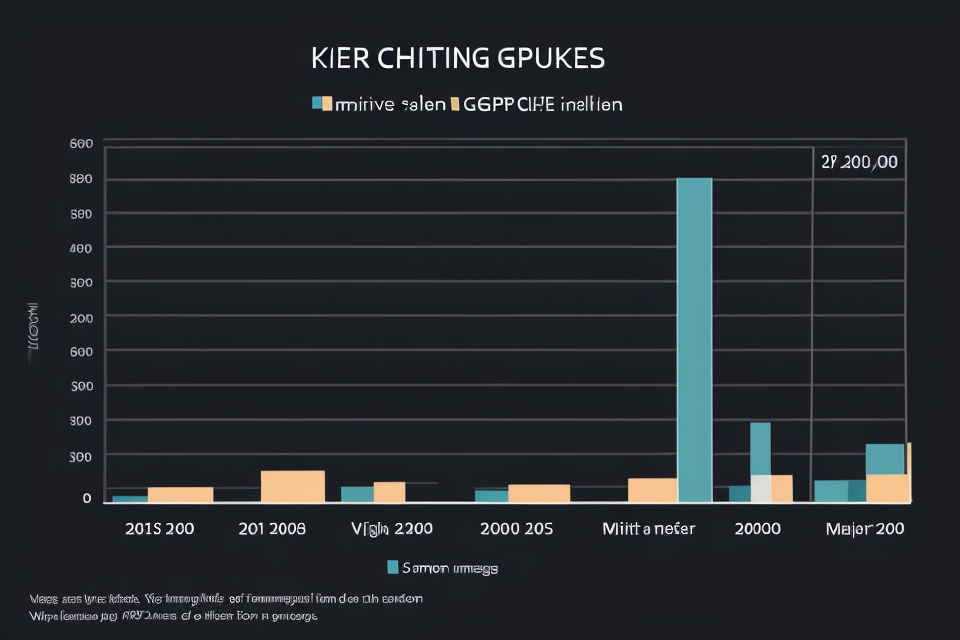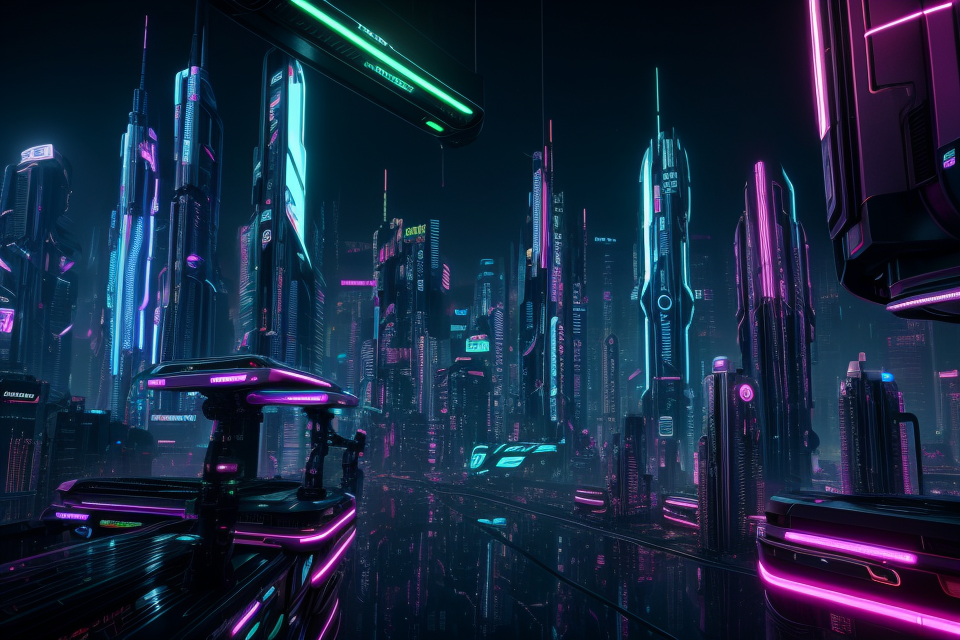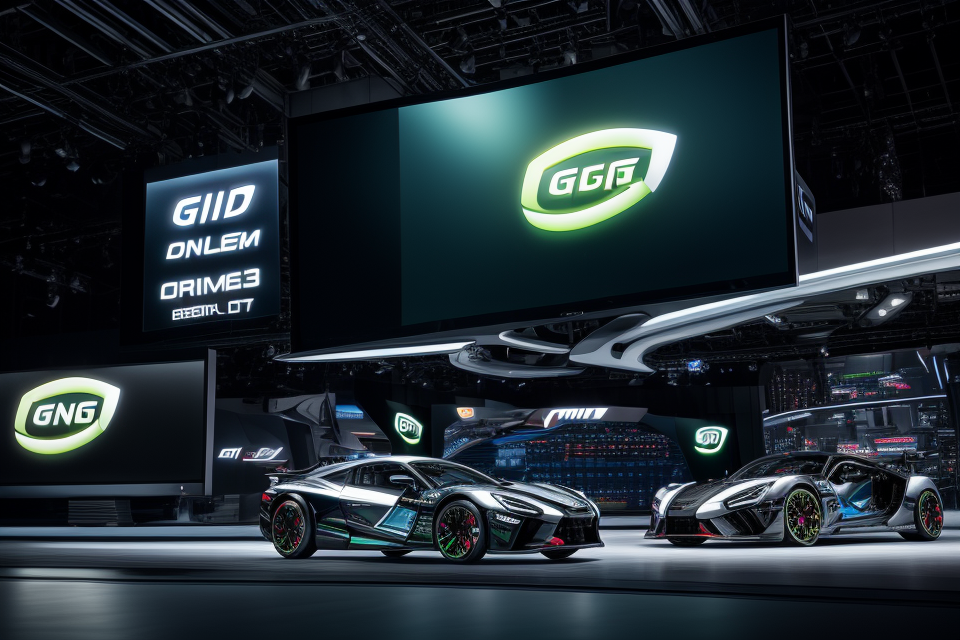
The GPU market has been a topic of much discussion in recent years, with many experts debating whether it is expanding or stagnating. On one hand, the demand for GPUs has been on the rise due to their increasing use in various industries such as gaming, automotive, and healthcare. On the other hand, some experts argue that the market has reached a saturation point and that growth is no longer sustainable. In this article, we will delve into the current state of the GPU market and provide a comprehensive analysis of its growth prospects. We will examine the key drivers of demand, the competitive landscape, and the challenges facing the industry. So, buckle up and get ready to find out if the GPU market is speeding ahead or slowing down.
GPU Market Overview
Historical Growth and Market Dominance
Evolution of GPU Technology
The evolution of GPU technology has been marked by several significant milestones that have contributed to its increasing use in various industries. The first GPUs were primarily used for gaming, providing graphical acceleration to improve the gaming experience. However, with the rise of machine learning and artificial intelligence, the demand for GPUs increased as they proved to be highly efficient in handling complex computations required for these applications.
Market Share of Major GPU Manufacturers
The GPU market has been dominated by a few major players, including NVIDIA and AMD. NVIDIA has been a leader in the GPU market, accounting for a significant portion of the market share. AMD, on the other hand, has been able to carve out a niche for itself in the mid-range and high-end segments of the market.
Impact of Technological Advancements on the GPU Market
Technological advancements have played a significant role in the growth of the GPU market. The development of new technologies such as deep learning, neural networks, and machine learning has led to an increase in demand for GPUs in these industries. Additionally, the rise of cloud computing has provided new opportunities for GPU providers to offer their services to a wider audience.
In conclusion, the GPU market has experienced significant growth over the years, driven by technological advancements and increasing demand from various industries. The market is dominated by a few major players, with NVIDIA being the market leader. However, there is still room for growth and innovation in the market, and it will be interesting to see how the market evolves in the coming years.
Factors Driving Market Growth
Increasing demand for AI and machine learning applications
- The growing adoption of AI and machine learning across various industries, including healthcare, finance, and manufacturing, has led to an increased demand for GPUs.
- The need for real-time processing and data-intensive tasks makes GPUs the preferred choice for these applications.
Rise in real-time 3D rendering and visualization
- The increasing use of 3D modeling and visualization in industries such as architecture, gaming, and film production has driven the demand for GPUs.
- Real-time rendering requires high processing power, which GPUs can provide, making them ideal for these applications.
Growing popularity of cryptocurrencies and mining
- The surge in cryptocurrency prices has led to an increase in cryptocurrency mining, which requires specialized hardware such as GPUs.
- This has led to a rise in demand for GPUs, especially among miners.
Emergence of virtual reality and augmented reality technologies
- The growing popularity of VR and AR technologies has created a demand for GPUs that can handle the processing requirements of these applications.
- VR and AR require high-quality graphics and real-time processing, making GPUs an essential component for these technologies.
Barriers to Market Expansion
Saturation in traditional gaming market
The traditional gaming market has reached a point of saturation, with many consumers already owning multiple GPUs. This means that the demand for new GPUs is not as high as it once was, as consumers are not necessarily in need of upgrading their existing hardware. As a result, the market for GPUs is becoming increasingly competitive, with manufacturers competing for a limited number of customers.
High entry barriers for new players
The GPU market is also characterized by high entry barriers for new players. This is due to the significant capital investment required to develop and manufacture high-quality GPUs. In addition, established players have already built up strong brand recognition and customer loyalty, making it difficult for new players to gain a foothold in the market.
Technological limitations and challenges
Technological limitations and challenges also pose a significant barrier to market expansion. The development of new and innovative GPUs requires significant research and development, as well as a deep understanding of the complex technologies involved. This means that new players entering the market face a steep learning curve and may struggle to keep up with the rapid pace of technological advancements.
Economic factors and market fluctuations
Finally, economic factors and market fluctuations can also pose a significant barrier to market expansion. The GPU market is highly sensitive to changes in the global economy, with fluctuations in demand often leading to price wars and decreased profitability for manufacturers. This means that new players entering the market must be prepared to navigate a volatile and unpredictable market, which can be challenging for those without experience in the industry.
GPU Technology Trends
Innovations in GPU Architecture
CUDA, OpenCL, and other programming models
The advancements in GPU architecture have enabled the development of sophisticated programming models, such as CUDA (Compute Unified Device Architecture) and OpenCL (Open Computing Language). These models facilitate the utilization of GPUs for general-purpose computing, thereby expanding their applications beyond traditional graphics processing.
CUDA, developed by NVIDIA, is a parallel computing platform and programming model that allows developers to harness the power of GPUs for various computing tasks. CUDA enables the execution of code on the GPU, utilizing its massive parallel processing capabilities to deliver significant performance gains for applications in fields such as scientific simulations, deep learning, and image processing.
OpenCL, on the other hand, is an open standard for programming heterogeneous systems, including GPUs, CPUs, and FPGAs. It provides a unified programming model that allows developers to write a single program that can be executed across different hardware platforms, thereby promoting hardware-agnostic development and fostering innovation in the field of heterogeneous computing.
Parallel processing and distributed computing
GPUs are designed to perform large-scale parallel processing, which makes them well-suited for distributed computing environments. By leveraging their ability to handle massive amounts of data in parallel, GPUs can significantly accelerate applications that require intensive processing, such as big data analytics, scientific simulations, and high-performance computing.
In recent years, there has been a growing trend towards distributed computing systems that leverage the power of GPUs across multiple nodes to solve complex problems. This approach involves dividing a large dataset or computation task into smaller pieces, which can be processed concurrently by multiple GPUs, thereby achieving faster results and greater efficiency.
Advanced memory and storage solutions
GPUs have evolved to incorporate advanced memory and storage solutions that enable them to handle increasingly complex workloads. The introduction of high-bandwidth memory (HBM) and stacked memory architectures has significantly increased the memory capacity and bandwidth of GPUs, allowing them to process larger datasets and more sophisticated algorithms.
In addition, GPUs are now being integrated with non-volatile memory technologies, such as 3D XPoint and PCM (Phase Change Memory), which offer higher data densities, faster access times, and improved energy efficiency compared to traditional memory technologies. These advancements in memory and storage solutions have played a crucial role in driving the growth of the GPU market.
Efficiency improvements through software optimizations
Software optimizations have also played a vital role in driving innovation in GPU architecture. Techniques such as just-in-time (JIT) compilation, automatic parallelization, and GPU-accelerated libraries have enabled developers to optimize their applications for GPU execution, thereby unlocking the full potential of GPU hardware.
JIT compilation involves converting code into machine code at runtime, which allows for faster execution and improved performance. Automatic parallelization involves identifying parallelizable sections of code and automatically converting them for execution on the GPU, thereby reducing the time and effort required for manual parallelization.
GPU-accelerated libraries, such as BLAS (Basic Linear Algebra Subprograms) and LAPACK (Linear Algebra Package), provide pre-optimized implementations of common linear algebra operations that can be executed on GPUs, delivering significant performance gains for a wide range of applications.
In conclusion, the innovations in GPU architecture, including the development of advanced programming models, parallel processing capabilities, advanced memory and storage solutions, and software optimizations, have played a crucial role in driving the growth of the GPU market. These advancements have expanded the potential applications of GPUs beyond traditional graphics processing, enabling them to be utilized for a wide range of computing tasks, and contributing to the overall expansion of the GPU market.
Advancements in Graphics APIs
The field of graphics processing units (GPUs) has seen significant advancements in recent years, particularly in the realm of graphics application programming interfaces (APIs). These APIs play a crucial role in determining the capabilities and functionality of GPUs, and their development has been instrumental in driving the growth of the GPU market.
DirectX and OpenGL
DirectX and OpenGL are two of the most widely used graphics APIs in the industry. DirectX is primarily used in Windows-based systems, while OpenGL is available across multiple platforms, including Windows, macOS, and Linux. Both APIs have undergone several iterations, with each new version bringing new features and capabilities to the table. For instance, DirectX 12 introduced support for low-level programming, allowing developers to access the GPU more efficiently and unlocking greater performance potential. Similarly, OpenGL 4.5 introduced features such as multiview rendering and multithreading, enabling more complex and efficient rendering processes.
Vulkan and other emerging APIs
In recent years, a new contender has emerged in the world of graphics APIs: Vulkan. Developed by the Khronos Group, Vulkan is a low-level API designed to provide greater control over GPU resources and unlock higher levels of performance. Vulkan’s emphasis on multithreading and the use of compute pipes allows for more efficient resource utilization, resulting in better performance and reduced latency. Additionally, Vulkan supports a wide range of platforms, including Windows, Linux, Android, and iOS, making it a versatile choice for developers.
Another notable API that has gained traction in recent years is Metal, developed by Apple. Metal is designed specifically for macOS and iOS, and it offers a high-level, low-overhead API that allows developers to access the GPU more efficiently. Metal also supports features such as GPU-accelerated compute and advanced rendering techniques, making it an attractive choice for developers working within the Apple ecosystem.
Real-time ray tracing and shading techniques
One of the most significant advancements in graphics APIs has been the introduction of real-time ray tracing and shading techniques. Ray tracing is a rendering technique that simulates the behavior of light in a scene, resulting in more realistic and accurate reflections, refractions, and shadows. The introduction of ray tracing support in APIs such as DirectX and OpenGL has enabled developers to create more visually stunning and immersive experiences in games and other applications.
In addition to ray tracing, advancements in shading techniques have also played a crucial role in enhancing the visual quality of GPU-powered applications. Programmable shaders allow developers to define complex algorithms for generating textures, lighting, and other visual effects, enabling greater customization and control over the rendering process. The introduction of features such as shader pipelines and high-level shading languages has made it easier for developers to harness the power of GPUs for advanced rendering techniques.
Multi-platform support and compatibility
Another important factor driving the development of graphics APIs is the need for multi-platform support and compatibility. As GPUs have become increasingly prevalent across a wide range of devices, from desktop computers to mobile phones, the demand for APIs that can support multiple platforms has grown. APIs such as Vulkan and Metal have been designed with this in mind, offering support for a wide range of platforms and devices.
Furthermore, the rise of cloud gaming and streaming services has led to the development of APIs that can support remote GPU acceleration. This technology allows users to access GPU-intensive applications and games on devices with less powerful hardware, leveraging the power of remote GPUs to provide a more seamless and immersive experience.
In conclusion, the world of graphics APIs has seen significant advancements in recent years, with new APIs emerging and existing APIs being updated to provide greater functionality and performance. These advancements have played a crucial role in driving the growth of the GPU market, enabling developers to create more visually stunning and immersive experiences across a wide range of devices and platforms.
GPU-Accelerated AI and Machine Learning
GPU-accelerated AI and machine learning have emerged as significant trends in the GPU market. These technologies have transformed the way businesses and organizations process and analyze data, leading to enhanced efficiency and accuracy in various applications. In this section, we will delve into the deep learning and neural networks, hardware acceleration for AI workloads, specialized GPUs for AI applications, and the integration of AI technologies with GPUs.
Deep Learning and Neural Networks
Deep learning is a subset of machine learning that utilizes artificial neural networks to analyze and learn from data. It has gained immense popularity due to its ability to recognize patterns and make predictions in complex datasets. Deep learning algorithms are particularly useful in applications such as image and speech recognition, natural language processing, and autonomous vehicles.
Hardware Acceleration for AI Workloads
To handle the computational demands of deep learning and other AI workloads, GPUs have emerged as a popular hardware solution. They offer significant advantages over CPUs in terms of parallel processing capabilities, enabling faster training and inference times for neural networks. This has led to a surge in demand for GPUs in various industries, including healthcare, finance, and transportation.
Specialized GPUs for AI Applications
In response to the growing demand for AI hardware, GPU manufacturers have developed specialized GPUs optimized for AI workloads. These GPUs feature specific architectures and memory configurations designed to accelerate deep learning and other AI tasks. Examples of such GPUs include NVIDIA’s Tesla series and AMD’s Radeon Instinct series.
Integration of AI Technologies with GPUs
The integration of AI technologies with GPUs has enabled businesses to develop innovative solutions that were previously unattainable. From virtual assistants and chatbots to autonomous vehicles and smart homes, the possibilities are endless. As AI continues to evolve, the demand for GPUs is expected to grow, driving the expansion of the GPU market.
Overall, the integration of GPU-accelerated AI and machine learning has transformed various industries, leading to enhanced efficiency, accuracy, and innovation. As these technologies continue to advance, the demand for GPUs is likely to increase, driving the growth of the GPU market.
Emerging Applications and Industries
The GPU market is continuously evolving and expanding into new applications and industries. The development of specialized GPUs and accelerators has enabled these emerging industries to leverage the power of GPUs to enhance their products and services.
Autonomous vehicles and robotics
Autonomous vehicles and robotics are rapidly advancing fields that heavily rely on GPUs for real-time processing and deep learning. The development of specialized GPUs like NVIDIA’s Drive platform and Intel’s Movidius Neural Compute Stick enable these applications to achieve high-performance and low-latency processing. The increasing demand for autonomous vehicles and robotics in industries such as transportation, logistics, and manufacturing is expected to drive the growth of the GPU market.
Healthcare and medical imaging
The healthcare industry is increasingly adopting GPUs for medical imaging and diagnostics. GPUs are used to accelerate image processing and analysis, enabling faster and more accurate diagnoses. Specialized GPUs like NVIDIA’s Clara platform are designed specifically for healthcare applications, providing high-performance computing capabilities for medical imaging and research.
Scientific simulations and research
GPUs are becoming essential tools for scientific simulations and research. The ability of GPUs to perform parallel processing allows for faster and more efficient simulations, enabling researchers to process large datasets and run complex simulations. Specialized GPUs like NVIDIA’s Tesla platform are designed for high-performance computing, providing researchers with the computational power needed for scientific simulations and research.
Professional visualization and design
Professional visualization and design applications like computer-aided design (CAD) and virtual reality (VR) are increasingly leveraging the power of GPUs. GPUs enable real-time rendering and simulation, providing designers and engineers with the ability to create more realistic and immersive visualizations. Specialized GPUs like NVIDIA’s Quadro platform are designed for professional visualization and provide high-performance graphics capabilities for applications like architecture, engineering, and entertainment.
Overall, the GPU market is expanding into new applications and industries, driven by the increasing demand for high-performance computing and visualization capabilities. As the adoption of GPUs continues to grow in these emerging industries, the GPU market is expected to experience significant growth in the coming years.
Future Prospects of the GPU Market
Potential Growth Opportunities
The potential growth opportunities for the GPU market are numerous and diverse. These opportunities can be broadly categorized into four key areas:
Expansion into new markets and industries
One of the primary growth opportunities for the GPU market is the expansion into new markets and industries. The increasing demand for GPUs in fields such as healthcare, education, and entertainment presents a significant opportunity for growth. In healthcare, for example, GPUs are being used to accelerate the processing of medical images and simulations, which can improve diagnostic accuracy and treatment planning. Similarly, in education, GPUs are being used to create more immersive and interactive learning experiences, which can enhance student engagement and learning outcomes.
Development of new GPU technologies and architectures
Another potential growth opportunity for the GPU market is the development of new GPU technologies and architectures. As the demand for more advanced graphics and computing capabilities continues to increase, GPU manufacturers are investing in research and development to create new and innovative technologies. For example, the emergence of AI and machine learning has led to the development of specialized GPUs that are optimized for these applications. Additionally, the continued evolution of 3D graphics and virtual reality requires new GPU architectures that can handle the increased processing demands of these technologies.
Integration with other hardware components
The integration of GPUs with other hardware components is another potential growth opportunity for the GPU market. As the demand for more powerful and efficient computing systems increases, there is a growing trend towards the integration of GPUs with CPUs and other hardware components. This integration can provide significant benefits in terms of performance, power efficiency, and cost-effectiveness. For example, the integration of GPUs with CPUs can enable more powerful and efficient processing of data, which can benefit applications such as scientific simulations and data analytics.
Continued demand for advanced graphics and computing capabilities
Finally, the continued demand for advanced graphics and computing capabilities represents a significant growth opportunity for the GPU market. As the use of graphics and visualization technologies continues to expand across a wide range of industries, the demand for more powerful and efficient GPUs is likely to increase. This demand is being driven by factors such as the growing use of virtual and augmented reality, the increasing use of 3D modeling and simulation, and the ongoing evolution of AI and machine learning.
Overall, the potential growth opportunities for the GPU market are significant and diverse. As the demand for advanced graphics and computing capabilities continues to increase, the GPU market is likely to expand into new markets and industries, develop new technologies and architectures, integrate with other hardware components, and continue to drive innovation in a wide range of fields.
Challenges and Uncertainties
Competition from Emerging Technologies
The GPU market faces intense competition from emerging technologies such as AI accelerators, FPGAs, and TPUs. These alternative solutions are specifically designed to handle the computational demands of AI and machine learning workloads, which have traditionally been the domain of GPUs. As a result, these emerging technologies pose a significant threat to the dominance of GPUs in the market.
Fluctuations in Market Demand and Consumer Preferences
The demand for GPUs is subject to fluctuations due to changes in consumer preferences and market trends. For instance, the popularity of cryptocurrencies has led to a surge in demand for GPUs in the past, but this demand can be volatile and difficult to predict. Additionally, the rise of cloud computing and virtualization has reduced the need for high-performance GPUs in personal computers, which could impact the sales of GPUs in the consumer market.
Environmental Concerns and Sustainability
The GPU market also faces challenges related to environmental concerns and sustainability. The increasing power consumption of GPUs has raised concerns about their energy efficiency and environmental impact. As a result, there is a growing demand for more energy-efficient GPUs that can reduce the carbon footprint of data centers and other computing infrastructure. This trend towards sustainability could impact the sales of GPUs that do not meet the stringent energy efficiency standards of the future.
Potential Regulatory Changes and Legal Challenges
Finally, the GPU market faces potential regulatory changes and legal challenges that could impact its growth. Regulations related to data privacy, security, and compliance are becoming increasingly stringent, which could affect the adoption of GPUs in certain industries and applications. Additionally, the legal battles surrounding intellectual property rights and patent infringement could create uncertainty and instability in the market, which could discourage investment and innovation in the GPU industry.
FAQs
1. What is a GPU?
A GPU (Graphics Processing Unit) is a specialized type of processor designed to handle the rendering of images and graphics. It is commonly used in applications such as video games, 3D modeling, and scientific simulations.
2. What is the current state of the GPU market?
The GPU market is constantly evolving and expanding. The demand for GPUs has been increasing as more and more applications require the ability to handle complex graphics and visualizations. Additionally, the rise of artificial intelligence and machine learning has also led to an increased demand for GPUs.
3. What are some of the key players in the GPU market?
Some of the key players in the GPU market include NVIDIA, AMD, and Intel. These companies have been leading the development of GPU technology and have a significant presence in the market.
4. What are some of the factors driving the growth of the GPU market?
There are several factors driving the growth of the GPU market. These include the increasing demand for graphics-intensive applications, the rise of artificial intelligence and machine learning, and the need for faster and more efficient processing of large amounts of data.
5. What are some of the challenges facing the GPU market?
One of the main challenges facing the GPU market is the high cost of development and manufacturing. Additionally, there is a limited supply of skilled engineers and designers who are able to create advanced GPU technology.
6. What is the future outlook for the GPU market?
The future outlook for the GPU market is positive, with continued growth and expansion expected in the coming years. As the demand for graphics-intensive applications and artificial intelligence continues to increase, the need for advanced GPU technology will also grow. Additionally, the development of new manufacturing techniques and the increased availability of skilled engineers and designers may help to drive down costs and increase the availability of GPU technology.


